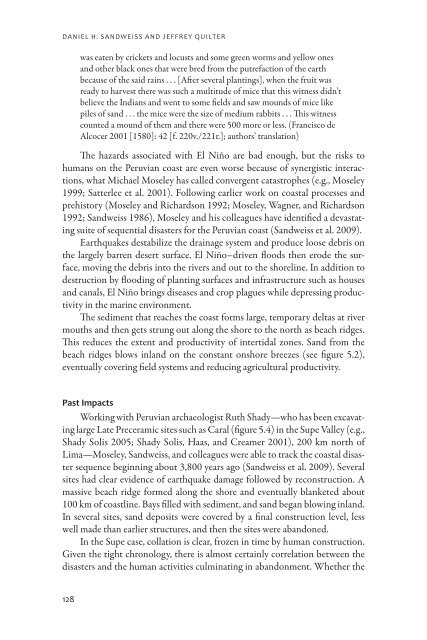free download - University Press of Colorado
free download - University Press of Colorado
free download - University Press of Colorado
Create successful ePaper yourself
Turn your PDF publications into a flip-book with our unique Google optimized e-Paper software.
Daniel H. Sandweiss and Jeffrey Quilter<br />
was eaten by crickets and locusts and some green worms and yellow ones<br />
and other black ones that were bred from the putrefaction <strong>of</strong> the earth<br />
because <strong>of</strong> the said rains . . . [After several plantings], when the fruit was<br />
ready to harvest there was such a multitude <strong>of</strong> mice that this witness didn’t<br />
believe the Indians and went to some fields and saw mounds <strong>of</strong> mice like<br />
piles <strong>of</strong> sand . . . the mice were the size <strong>of</strong> medium rabbits . . . This witness<br />
counted a mound <strong>of</strong> them and there were 500 more or less. (Francisco de<br />
Alcocer 2001 [1580]: 42 [f. 220v./221r.]; authors’ translation)<br />
The hazards associated with El Niño are bad enough, but the risks to<br />
humans on the Peruvian coast are even worse because <strong>of</strong> synergistic interactions,<br />
what Michael Moseley has called convergent catastrophes (e.g., Moseley<br />
1999; Satterlee et al. 2001). Following earlier work on coastal processes and<br />
prehistory (Moseley and Richardson 1992; Moseley, Wagner, and Richardson<br />
1992; Sandweiss 1986), Moseley and his colleagues have identified a devastating<br />
suite <strong>of</strong> sequential disasters for the Peruvian coast (Sandweiss et al. 2009).<br />
Earthquakes destabilize the drainage system and produce loose debris on<br />
the largely barren desert surface. El Niño–driven floods then erode the surface,<br />
moving the debris into the rivers and out to the shoreline. In addition to<br />
destruction by flooding <strong>of</strong> planting surfaces and infrastructure such as houses<br />
and canals, El Niño brings diseases and crop plagues while depressing productivity<br />
in the marine environment.<br />
The sediment that reaches the coast forms large, temporary deltas at river<br />
mouths and then gets strung out along the shore to the north as beach ridges.<br />
This reduces the extent and productivity <strong>of</strong> intertidal zones. Sand from the<br />
beach ridges blows inland on the constant onshore breezes (see figure 5.2),<br />
eventually covering field systems and reducing agricultural productivity.<br />
Past Impacts<br />
Working with Peruvian archaeologist Ruth Shady—who has been excavating<br />
large Late Preceramic sites such as Caral (figure 5.4) in the Supe Valley (e.g.,<br />
Shady Solis 2005; Shady Solis, Haas, and Creamer 2001), 200 km north <strong>of</strong><br />
Lima—Moseley, Sandweiss, and colleagues were able to track the coastal disaster<br />
sequence beginning about 3,800 years ago (Sandweiss et al. 2009). Several<br />
sites had clear evidence <strong>of</strong> earthquake damage followed by reconstruction. A<br />
massive beach ridge formed along the shore and eventually blanketed about<br />
100 km <strong>of</strong> coastline. Bays filled with sediment, and sand began blowing inland.<br />
In several sites, sand deposits were covered by a final construction level, less<br />
well made than earlier structures, and then the sites were abandoned.<br />
In the Supe case, collation is clear, frozen in time by human construction.<br />
Given the tight chronology, there is almost certainly correlation between the<br />
disasters and the human activities culminating in abandonment. Whether the<br />
128





